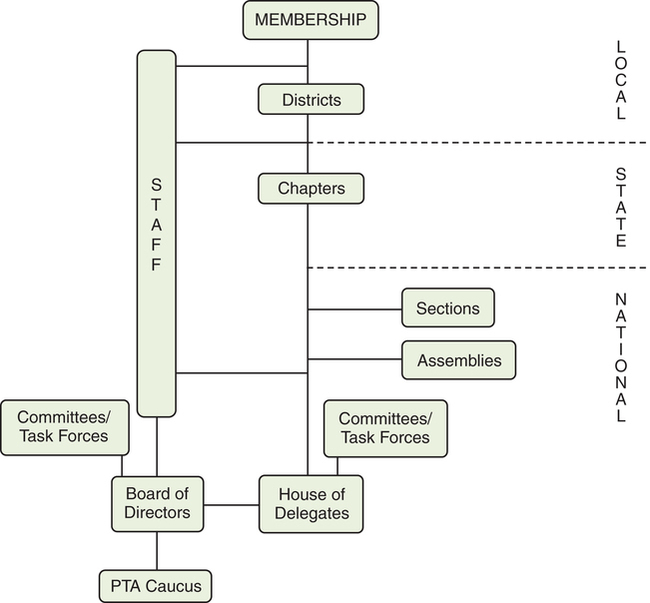After reading this chapter, the reader will be able to: American Board of Physical Therapy Specialties (ABPTS) American Physical Therapy Association (APTA) annual conference and exposition Commission on Accreditation in Physical Therapy Education (CAPTE) Federation of State Boards of Physical Therapy (FSBPT) Foundation for Physical Therapy TriAlliance of Health and Health and Rehabilitation Professions (TriAlliance) The definition of physical therapy presented in Chapter 1 demonstrates that this discipline is a profession, because it possesses all the qualities or criteria of a profession. One of these criteria is a representative organization. This chapter focuses on the American Physical Therapy Association (APTA), which is the national organization that represents the physical therapy profession. The organization’s mission, structure, and benefits are described here. A historical account of the Association was presented in Chapter 1. Affiliated and related organizations representing physical therapy interests are included at the end of this chapter. The APTA is a national member-driven organization that represents the profession of physical therapy (Figure 4-1). It is composed of more than 78,000 physical therapists (PTs), physical therapist assistants (PTAs), and students throughout the United States and abroad. Membership is strictly voluntary. In 1993 the House of Delegates (HOD) of the APTA adopted a mission statement and related policy. The statement1 (Box 4-1) and policy2 (Box 4-2) demonstrate the profession’s interest in serving the public and its members through practice, education, and research. Goals for the APTA are proposed by the Board of Directors (BOD). They are then reviewed and approved by the HOD. The current goals were approved by the HOD in June 2005 and are presented in Box 4-3.3 These goals direct the activities and funding priorities for the new year and reiterate the grounding in education, research, and practice. They are anchored in the Vision 2020 Statement and further promote activities to attain this vision. (See Chapter 1 for further description of Vision 2020.) The organizational structure of the APTA is depicted in Figure 4-2. This structure provides a three-tiered approach (local, state, and national) to serve the members and the public. Three units at the state and national levels—chapters, sections, and assemblies—are the components of the APTA. Policymaking bodies, with their respective committees and task forces, and staff complete the general plan of this organization. Each level is described in this section, beginning with the primary unit, the membership. The primary membership categories of the APTA are physical therapist, physical therapist assistant, and their respective student categories.4 Other categories include life, retired, corresponding, honorary (not a member in any other category and has made outstanding contributions to the APTA or health of the public), and Catherine Worthingham Fellow of the APTA (physical therapist member for at least 15 years who has made notable contributions to the profession; may use the initials FAPTA). Requirements for membership include graduation from (or enrollment in) an education program approved by (or seeking candidacy from) a recognized accrediting agency. In addition, the applicant must sign a pledge indicating compliance with the Code of Ethics (physical therapist and related categories) or Standards of Ethical Conduct for the Physical Therapist Assistant (physical therapist assistant and related categories) and pay dues. As noted in Figure 4-2, a district is the most local organizational unit in the structure of APTA. Districts do not exist in all jurisdictions, such as small states. Membership is automatic where they do exist and may be based on location of residence or employment as provided in the bylaws of APTA. In accordance with the standing rules of APTA, a chapter “must coincide with or be confined within the legally constituted boundaries of a state, territory, or commonwealth of the United States or the District of Columbia.”4 In 2011 APTA consisted of 51 chapters—one for each state, and the District of Columbia. Membership in a chapter is automatic and based on location of residence, employment, education, or greatest active participation (in the last case, only in an immediately adjacent chapter). In contrast to districts, which are not permitted to assess dues, each chapter requires dues from PT and PTA members and, in a few cases, student members.
American Physical Therapy Association
 Describe the structure and function of the American Physical Therapy Association
Describe the structure and function of the American Physical Therapy Association
 Distinguish between sections and assemblies within the Association
Distinguish between sections and assemblies within the Association
 Identify and describe organizations that are associated with and related to the Association
Identify and describe organizations that are associated with and related to the Association
 Describe the benefits of belonging to the Association
Describe the benefits of belonging to the Association
Mission and Goals
Organizational Structure
Membership
Districts
Chapters
![]()
Stay updated, free articles. Join our Telegram channel

Full access? Get Clinical Tree


Musculoskeletal Key
Fastest Musculoskeletal Insight Engine











